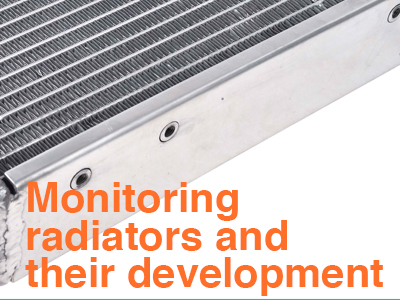Fitting instructions for Remote Vacuum Servo Units Types 6 and 7
General fitting instructions
To ensure correct installation of the AP Braking remote vacuum servo unit, thoroughly read and adhere to the fitting instructions prior to carrying out any work on the vehicle. Introduction The vacuum servo unit is incorporated into the hydraulic braking system, remote from the master cylinder, as an intermediate stage operating between the master cylinder and the brake assemblies. The two main parts of the servo unit consist of the vacuum servo mechanism and the hydraulic slave cylinder assembly.
These component parts are bolted together so that the slave cylinder piston is in line with, and is operated by, the servo push rod. A plastic no-return valve is fitted into the vacuum shell and an integral air cleaner is incorporated to prevent foreign matter entering the air control valve chamber. The servo unit is designed to give no assistance with very light brake application. In the absence of servo assistance due to loss of vacuum, an unres...
Camshaft Design
Elgin Cams is a company that is a direct descendent of such famous California specialists as Isky, Delong, Winfield, etc. etc. Elgin has taken the art of cams into the science of the '90's. Computer designed and handcrafted workmanship guarantee a first class camshaft. Custom designed cams are a specialty.
Part No Applications: CAM001, CAM002, CAM003, CAM004, CAM005, CAM006, CAM007
Elgin has made cams or sold his design to General Motors, Ford Motor Co., Nissan Corp., Zakespped International, Porsche Motor Sports, Winston Cup "Engine Builders. Elgin has the largest percentage of cams used at the SCCA Runoffs from GT-1 to Formula-V. He also has provided original or new technology for antique and vintage racers.
Much information has been recorded about the four stroke internal combustion engine and yet only a small percentage of people really understand how it works and fewer people know how to modify an engine to suit their needs.
Distributor - Initial ignition timing set-up.
Any deviation away from the original standard engine specification, or where a dizzy from another source is used in the engine you have, the ignition timing will generally be different from that set by the manufacturer.
Terminology -
Dizzy - Distributor
TDC - Top Dead Centre
BTDC - Before Top Dead Centre
ATDC - After Top Dead Centre
CR - Compression Ratio
Tacho - Tachometer, rev counter (not to be confused with Mexican food delicacy!)
Vac - vacuum (pipe, unit, etc.)
Any deviation away from the original standard engine specification, or where a dizzy from another source is used in the engine you have, the ignition timing will generally be different from that set by the manufacturer.
Distributors - Modifying them, how, where, and who
When a known engine build formula is used, dizzies can be churned out with the relevant advance curve to suit - as in standard production engines.
Terminology -
Dizzy - Distributor
When a known engine build formula is used, dizzies can be churned out with the relevant advance curve to suit - as in standard production engines. Reading the 'dizzy working basics' article defines what the dizzy does and how. It's pretty obvious then that any changes at all in the original engine specification is likely to require a different advance curve. This is where most folk fall down when completing the ‘build for power’, by assuming that an alternative dizzy from a sportier or similarly powered engine will do the trick.A simple illustration is folk's preoccupation with sticking a 'S' dizzy into anything tuned in the belief this is the way to go. It's not. It's likely to be as useful as the one you have.
Distributors - working basics
To maximise power and economy potential from any engine, burning the compressed fuel/air mixture at precisely the right point throughout the engines entire rpm range is essential.
Terminology -
TDC - Top Dead Centre
BTDC - Before Top Dead Centre
Dizzy - distributor
CR - compression ratio
To maximise power and economy potential from any engine, burning the compressed fuel/air mixture at precisely the right point throughout the engines entire rpm range is essential. This ‘point’ is generally somewhere before the piston reaches TDC on its power stroke described in degrees - i.e. 10 degrees BTDC. This point isn’t constant throughout the rpm range. Low rpm values are normally less than high ones.
Ultimately the dizzy provides this spark at exactly the right point to effect this burn.
Ignition - Pertronix Ignitor issues
I have been using the Ignitor ignition systems for some 8 years or so, as long as they have available in the UK, and have never found fault with them nor had any reliability issues. Until the beginning of this year…
A new customer for this year, racing an MG Midget here in UK under a limited mods category, was doing splendidly for the first couple of races, then started experiencing a misfire. Initially it was believed to be a fuel starvation/vaporization issue. All fuel pipes were checked and re-routed where it was considered necessary. Those still considered in danger of getting too warm were heat shielded. The misfire persisted. On to the ignition system. All was checked, but then a loose alternator wire was found and blamed for the fault. It wasn't. Back to the ignition system then.
SU Carbs - Dashpot oil
This subject is a regular message-board poser. Many of us have touted our preferences and discoveries whilst playing about over the years.
One problem with trying to deal with it on the message board is the sheer volume of information offered and available against the time availab Classic example - the MG Metro. Its adventurously sporty cam makes for a slightly lumpy idle. This increases idle speed emissions, so Rover use manifold-sourced vacuum to increase idle speed ignition timing via the vac advance. It is a little on the thin side, but the whole engine tuning data for each engine is based on using this oil. Used as such it works very well, especially where economy is the main goal and the car is driven very sympathetically.
ATF - 'automatic transmission fluid'. A very good substitute where the genuine SU dashpot oil isn't available for use in STANDARD spec engines.
Vac pipe take-off
On some HIF carbs, the vac take-off sighted just after the butterfly - that's between the butterfly and the carb to manifold mounting flange - has been eliminated.
Instead, the engines these carbs are fitted to use a vac take off in the manifold. The reason for this is again wholly idle emissions orientated. The higher vacuum that exists in the manifold area can be used to pull more ignition advance. Theoretically this will reduce emissions at idle. Unfortunately it's exposed to induction pulsing. In the A-series, this is UGLY. The pulsing and high manifold vacuum causes rough idling. Particularly where anything 'sportier' (ANYTHING) than a bog-stock-standard cam profile is used.
Classic example - the MG Metro. Its adventurously sporty cam makes for a slightly lumpy idle. This increases idle speed emissions, so Rover use manifold-sourced vacuum to increase idle speed ignition timing via the vac advance.
SU Carbs - HIF, a more finely honed instrument
Modern technology continually sweeps its ever-growing arm across all manufactured products and the SU was no exception. From closer scrutiny, and more demanding emissions control the HIF variant was born. So what have they done to improve it over its predecessor - the HS - and is it worth hanging out for? PROS. Integral float - the 'IF' in the new type number HIF. The previous H and HS type carbs with their side-mounted remote float bowls worked fine until used in racing where serious cornering speeds generated enough G-forces to lean-out the fuel mixture. The remedy was to fit a spacer between the float lid and float bowl to raise the fuel level held in it. OK when running, but at idle and rest, fuel would bubble out of the jet - causing bore washing, poor pick-up, and horrendously rich CO mixtures at idle! Fitting the float integral with the carb, directly below the jet hole (port/orifice), eliminated this problem. Jet temperature compensation - This was first aired on HS types
SU Carbs - Poor idle quality
Something that crops up when any modifications are made to an engine - mainly in the form of improving induction and exhaust capability - is that of idle quality.
After applying aforementioned freer-breathing products to enhance power output, many complain that no matter what - including post rolling-road tuning - they can not get a satisfactory, steady idle setting. And this after checking for manifold/gasket air leaks and spindle to carb body play (usual suspect as the spindle wears quite dramatically over several thousand miles). There is one thing that is often over-looked - the air valve found on many later model cars. This sprung-loaded air valve is built into the butterfly, sometimes called a 'poppet' valve or anti-dive valve. It is primarily there to reduce emissions when the engine is on the over-run - closed throttle at speed, i.e. anything other than at idle and gearbox in neutral.
SU Carbs - The history
Practically every Mini owner can name the brilliant engineer responsible for our obsession. Many can name the man responsible for the rubber suspension spring.
A goodly number know a fair bit about the engine's heritage and the man who came up with the extremely efficient cylinder head design.They account for the biggest chunks of the Mini's anatomy. But what about that other extremely simple yet hugely effective instrument that features so prominently when engine tuning occurs - the SU carburetter? A limited few can tell you what 'SU' stands for, extremely few have any idea of its concept and evolution. So let's put that right… In the beginning Strangely enough, it all started way back with William Banks Skinner; one of the owners/directors of the well-known Lilly and Skinner footwear distributors.
New CSI electronic ignition distributors
We now have a new range of electronic ignition distributors available.
Choice of radiators

Choice of radiators
Radiators Read about heat conductivity, core, fin design, tube sizes and design changes
Monitoring Radiators development since 1960.

Monitoring Radiators development since 1960.
I have been monitoring radiators and their development since the late 1960’s because they were and still can be a problem when tuning cars.
I have seen,
tried and tested everything made available or offered to Mini Spares
Historical Article-February 1995-Calver's Clinic
Calver's Clinic
COOKING OIL
This engine oil thing seems to have caught people's attention - which is good as there is nothing like awareness of what is good for your engine. Having done the 'Life Blood' article in Minitech News 6, and what oils to avoid in Mini Tech News 7.
Historical Article-February 1995-Calver's Clinic
Calver's Clinic
COOKING OIL
This engine oil thing seems to have caught people's attention - which is good as there is nothing like awareness of what is good for your engine. Having done the 'Life Blood' article in Minitech News 6, and what oils to avoid in Mini Tech News 7.
|